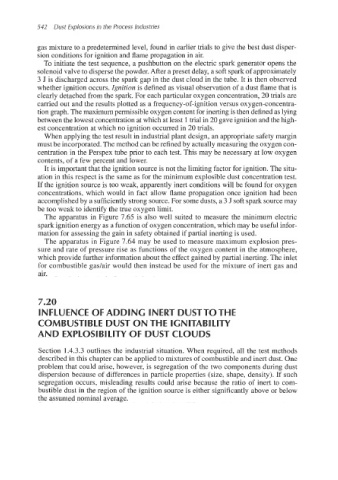Page 575 - Dust Explosions in the Process Industries
P. 575
542 Dust Explosions in the Process Industries
gas mixture to a predetermined level, found in earlier trials to give the best dust disper-
sion conditions for ignition and flame propagation in air.
To initiate the test sequence, a pushbutton on the electric spark generator opens the
solenoid valve to dispersethe powder.After a preset delay, a soft spark of approximately
3 J is discharged across the spark gap in the dust cloud in the tube. It is then observed
whether ignition occurs. Ignition is defined as visual observation of a dust flame that is
clearly detached from the spark. For each particular oxygen concentration, 20 trials are
carried out and the results plotted as a frequency-of-ignitionversus oxygen-concentra-
tion graph.The maximumpermissible oxygen content for inerting is then defined as lying
between the lowest concentration at which at least 1trialin 20gave ignition and the high-
est concentration at which no ignition occurred in 20 trials.
When applying the test result in industrial plant design, an appropriate safety margin
must be incorporated.The method can be refined by actually measuringthe oxygen con-
centration in the Perspex tube prior to each test. This may be necessary at low oxygen
contents, of a few percent and lower.
It is important that the ignition source is not the limiting factor for ignition. The situ-
ation in this respect is the same as for the minimum explosible dust concentration test.
If the ignition source is too weak, apparently inert conditions will be found for oxygen
concentrations, which would in fact allow flame propagation once ignition had been
accomplishedby a sufficientlystrong source. For some dusts, a 3 J soft spark sourcemay
be too weak to identify the true oxygen limit.
The apparatus in Figure 7.65 is also well suited to measure the minimum electric
spark ignition energy as a function of oxygen concentration,which may be useful infor-
mation for assessing the gain in safety obtained if partial inerting is used.
The apparatus in Figure 7.64 may be used to measure maximum explosion pres-
sure and rate of pressure rise as functions of the oxygen content in the atmosphere,
which provide further information about the effect gained by partial inerting. The inlet
for combustible gadair would then instead be used for the mixture of inert gas and
air.
7.20
INFLUENCE OF ADDING INERT DUSTTOTHE
COMBUSTIBLE DUST ON THE IGNlTABlLlTY
AND EXPLOSlBlLlTY OF DUST CLOUDS
Section 1.4.3.3 outlines the industrial situation. When required, all the test methods
described in this chapter can be applied to mixtures of combustible and inert dust. One
problem that could arise, however, is segregation of the two components during dust
dispersion because of differences in particle properties (size, shape, density). If such
segregation occurs, misleading results could arise because the ratio of inert to com-
bustible dust in the region of the ignition source is either significantly above or below
the assumed nominal average.

